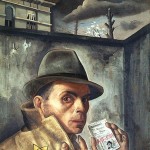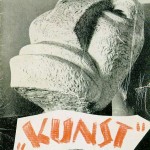So here we are, starting our blog. Since there are two of us, you can imagine how much we’ve discussed why we want to write a blog (to talk about art in general and our art in particular), how often we should write (Deb says once a week, but I remain a tad skeptical), and who our targeted audience will be (you, people interested in art in general and fiber art in particular, artists interested in taking one of our classes, people interested in technology and art, and those surfers out there who just happened to google one of our favorite terms).
Since we met in our university’s German Club oh so many years ago – you know, when people thought it was important to have a rounded education which always meant to learn at least one foreign language and the culture of the people who spoke it – we wanted our first post to be about German art. We still gravitate to it, love the Bauhaus movement, Expressionist painters, and the Romantics. Since today is Holocaust Remembrance Day, we dedicate this first post to all the artists whose lives and work suffered during the Nazi Regime.

We want to remember Otto Dix, whose searing portraits of wounded WWI veterans, prostitutes, and city dwellers captured the essence of an entire epoch. I always think of Deb when I see this portrait of Sylvia von Harden. Deb would have been drinking a Cosmopolitan, smoking, and wearing a monocle had she lived in Berlin in the ’20s.

We want to remember Felix Nussbaum, whose paintings themselves became an act of Jewish resistance. Nussbaum was murdered in Auschwitz in 1944, but beforehand he asked that even if he died, “do not let my pictures die, show them to the public.”

For those of you who would like to read more about how thoroughly the Nazi government went about framing the discussion of art and controlling art creation, you might want to begin with Stephanie Barron’s Degenerate Art: the Fate of the Avant-Garde in Nazi Germany (1991). This book not only gives you a virtual tour of the Degenerate Art (entartete Kunst) Exhibition of 1937 but also provides biographies of the represented artists and essays on various aspects of art in the Third Reich. Mind boggling, perhaps, is not that a twelve-city tour of the exhibition drew over three million visitors to see something deemed degenerate but that, at the same time, around 16,000 modern art pieces were confiscated and then sold overseas, destroyed, or placed into the private collections of SS officers. After all, some of the greatest artists of the 20-century are represented in this exhibition (think Marc Chagall, Wassily Kandinsky, George Grosz, or Ernst Ludwig Kirchner – more on him in a future post). This is the art history we grew up with. It’s really no wonder, then, that we think all art is political.

One response to “A Day of Remembering”
Hi artists! I love your new blog. I went to the Degenerate art show several years ago in SF. I have the book from the show. It was a thought provoking experience. I am now reading Unbroken by Hillenbrand. Suggest you try it. Anita